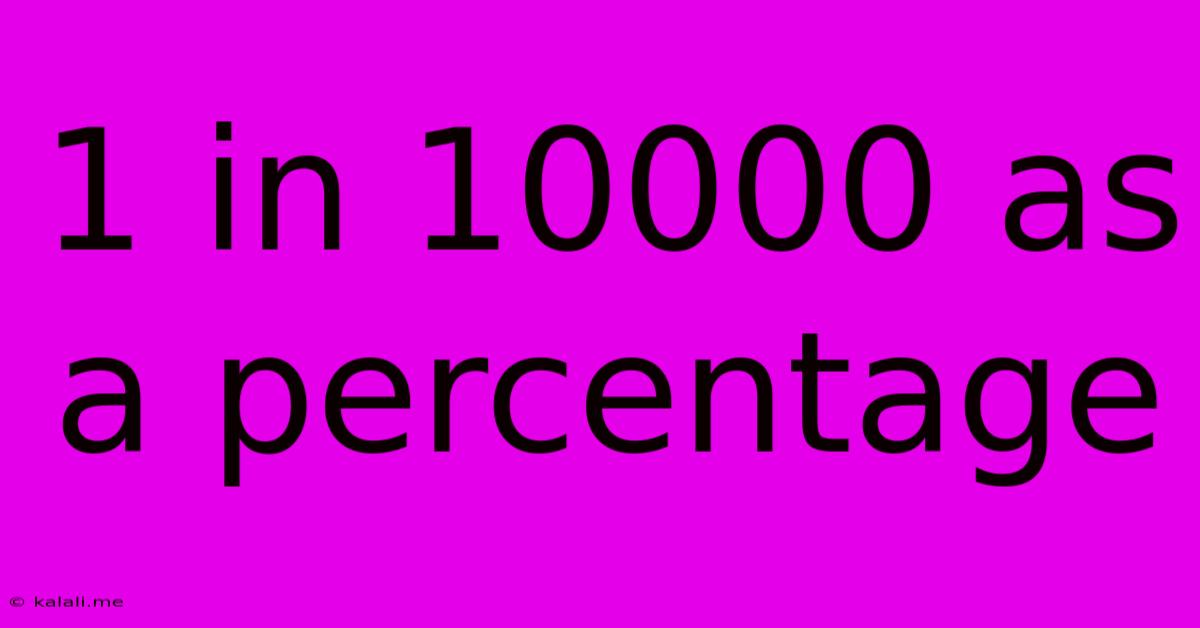1 In 10000 As A Percentage
Kalali
May 09, 2025 · 2 min read

Table of Contents
1 in 10,000 as a Percentage: A Simple Conversion Guide
Converting ratios like "1 in 10,000" into percentages can seem daunting, but it's a straightforward process with significant applications in various fields, from risk assessment to statistical analysis. This article provides a clear, step-by-step guide on how to perform this conversion and discusses its practical implications. Understanding this conversion helps you interpret data and communicate probabilities effectively.
What does "1 in 10,000" mean?
The ratio "1 in 10,000" indicates that for every 10,000 instances, a specific event occurs only once. This represents a relatively low probability. Thinking about this in terms of percentages allows for easier comparison with other probabilities expressed as percentages.
Converting the Ratio to a Percentage
To convert "1 in 10,000" to a percentage, follow these steps:
-
Express the ratio as a fraction: The ratio "1 in 10,000" can be written as the fraction 1/10,000.
-
Convert the fraction to a decimal: Divide the numerator (1) by the denominator (10,000): 1 ÷ 10,000 = 0.0001
-
Convert the decimal to a percentage: Multiply the decimal by 100 and add the percentage sign (%): 0.0001 x 100 = 0.01%.
Therefore, 1 in 10,000 is equal to 0.01%.
Practical Applications and Interpretations
Understanding how to express this low probability as a percentage is crucial in various contexts:
-
Risk Assessment: In fields like healthcare and finance, understanding the probability of rare events is paramount. A 0.01% chance of a specific side effect from a medication, for instance, provides a quantifiable measure of risk.
-
Statistical Analysis: Researchers often encounter extremely low probabilities in their data. Converting these probabilities to percentages facilitates comparison and interpretation of results.
-
Quality Control: In manufacturing, a 0.01% defect rate indicates a high level of quality control.
-
Data Visualization: Representing probabilities as percentages makes it easier to present complex data in a visually appealing and easily understandable manner using charts and graphs. A simple bar graph clearly shows the minute probability of 0.01%.
Comparing Probabilities
Expressing probabilities as percentages allows for easy comparison. For example, you can easily compare a 0.01% probability with a 1% probability or a 10% probability to understand the relative magnitude of risk or likelihood. This makes decision-making processes more informed.
In Conclusion:
Converting "1 in 10,000" to a percentage simplifies the representation of low-probability events. This conversion is a crucial skill in various fields, providing a clear and easily understandable way to communicate probabilities and facilitate data interpretation. The resulting 0.01% provides a concise and impactful representation of this relatively rare event.
Latest Posts
Latest Posts
-
What Percent Is 37 Out Of 50
May 10, 2025
-
What Is The Ultimate Source Of Energy
May 10, 2025
-
What Is 20 In Fraction Form
May 10, 2025
-
Cuantas Onzas Tiene Un Cuarto De Galon
May 10, 2025
-
How Many Inches Is 1 6 M
May 10, 2025
Related Post
Thank you for visiting our website which covers about 1 In 10000 As A Percentage . We hope the information provided has been useful to you. Feel free to contact us if you have any questions or need further assistance. See you next time and don't miss to bookmark.